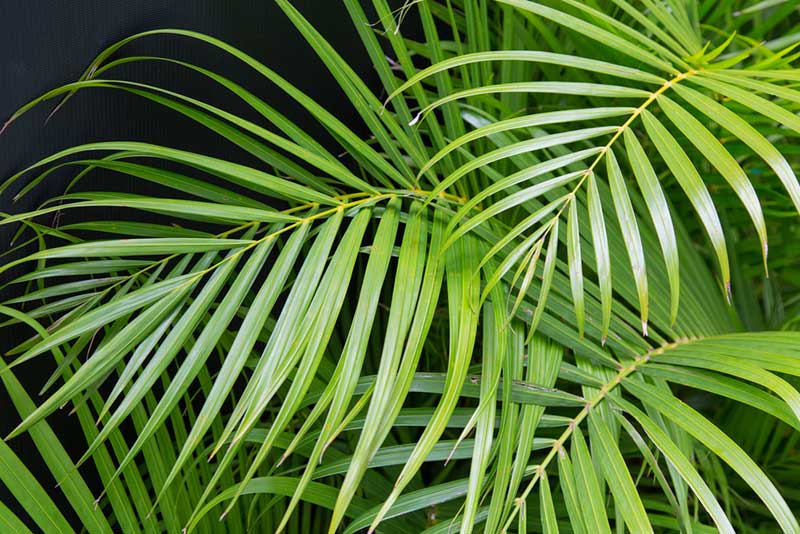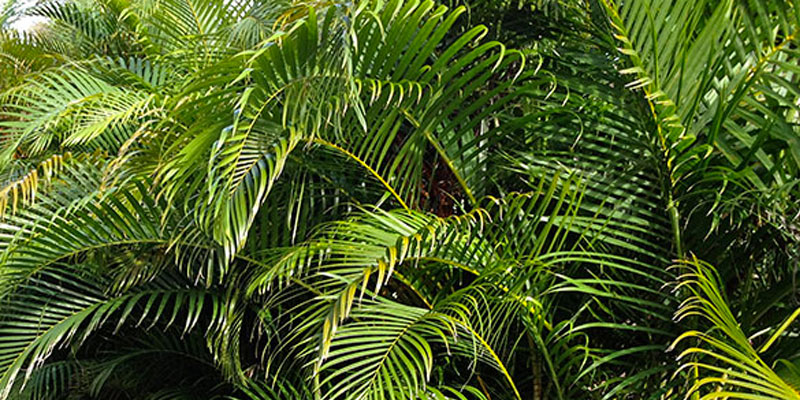
The Areca palm, which is a beautiful medium-sized palm, is a native of the island of Madagascar. Among indoor houseplants sold today, it consistently ranks as one of the most popular tropical palms used for indoor décor.
Indoors an Areca palm is slow growing with a medium spread and height. The exotic palm can reach a height of 6-8 feet at maturity when grown in ideal indoor conditions; outdoors that height can be as much as 25 feet when fully matured.
The Areca can also go by the common name of Butterfly palm, which it earned thanks to its long feathery fronds that branch off on a grouping of reed-like stems much like butterfly wings.
Each frond can be quite full and bushy with as many as 30 up to 60 leaflets on each one.
When young, the palm is green and fresh, and vibrant looking. As the palm grows and matures, it turns more a brown color in the stem area as the plant matures and hardens. Fronds at the bottom of the plant will begin to yellow and die and as the pal grows taller the woody stems become more defined and visible.
Care for the palm is easy and simple and the Areca can be grown indoors in most climates and outdoors in warm tropical regions of the country.
Pruning the Areca Palm
There are two main reasons why you would want or need to worry about pruning anything on the Areca palm. First is if any of the canes or fronds are badly damaged or are beginning to yellow or turn brown and die. The second is if any of the branching canes are getting in the way or ae interfering with the overall growth and shape of the palm. Here are some tips to help you with pruning your Areca Palm.
Pruning dead or damaged canes:
- Inspect the color of any canes (stems) that you want to cut. This is true on both indoor and outdoor-grown palms as both can experience due back at times for a number of reasons. Carefully looking at the canes before you start hacking away will ensure you are cutting the right areas at the right time. Healthy palm canes are a golden yellow with green wood and if the canes are brown or grey they are dead or rotting and must be removed as soon as possible.
- Slice off a thin area of bark from the cane you want to cut. Larger cans need no more than an area the size of your thumbnail and smaller canes require even less to be exposed. Check the color of the wood that is exposed. If it is green, your cane is alive and needs to e cut only if absolutely necessary. Brown or black wood means the can is dead and needs to be removed to protect the health of the palm.
- Cut off dead canes at ground level or as close as you can so less is left to rot around the palm. Snip small canes with sharp garden clippers or use a garden saw for thicker canes. Large outdoor palms more than 6-7 ft tall should be pruned by a professional.

Pruning growing canes to control growth:
For cutting and pruning of the Areca palm for the sake of maintaining the shape, size, and appearance the same general rules above will still apply. However, there are few additional things to consider when cutting back this palm indoors to keep it looking healthy and full:
- Consider how close the canes are. Sometimes with potted plants that have a lot of stems coming up from a central point, things can get a bit overcrowded. Thinning out the canes when the palm is young is always the best way to go as the bigger the canes are the harder they are to cut and the greater the risk of damage occurring.
- Look for canes and fronds that push into others or seem to cause problems with the overall growth and form of the plant. Again, it is easier to do this on a younger plant when the canes and fronds are thin and easier to cut.
- You will also want to consider how big the palm is and whether there is space for it to continue growing in the natural way it’s following or if things need to be cut and pruned back a little to keep things under control.






